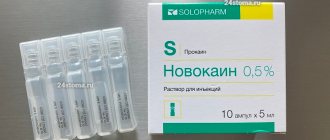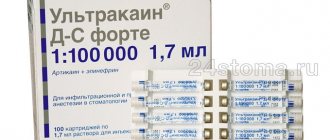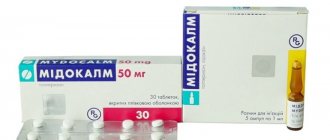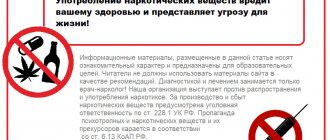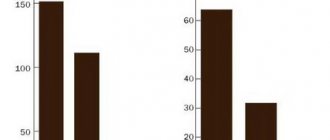LIDOCAINE
Directions for use and doses
The amount of solution and the total dose of lidocaine depends on the type of anesthesia, the nature and duration of the surgical intervention.
Method of diluting 20 mg/ml (2%) lidocaine solution to obtain a solution of the required concentration:
To prepare a 10 mg/ml (1%) lidocaine solution, you need to take 1 part of a 20 mg/ml lidocaine solution and 1 part of water for injection, i.e. mix 2 ml of 20 mg/ml lidocaine solution with 2 ml of water for injection (for a 2 ml ampoule), or mix 5 ml of 20 mg/ml lidocaine solution with 5 ml of water for injection (for a 5 ml ampoule).
To prepare a 5 mg/ml (0.5%) lidocaine solution, you need to take 1 part of a 20 mg/ml lidocaine solution and 3 parts of water for injection, i.e. mix 2 ml of 20 mg/ml lidocaine solution with 6 ml of water for injection (for a 2 ml ampoule), or mix 5 ml of 20 mg/ml lidocaine solution with 15 ml of water for injection (for a 5 ml ampoule).
To prepare a 2.5 mg/ml (0.25%) lidocaine solution, you need to take 1 part of a 20 mg/ml lidocaine solution and 7 parts of water for injection, i.e. mix 2 ml of a 20 mg/ml lidocaine solution with 14 ml of water for injection (for a 2 ml ampoule), or mix 5 ml of 20 mg/ml lidocaine solution with 35 ml of water for injection (for a 5 ml ampoule).
To prepare a 1.25 mg/ml (0.125%) lidocaine solution, you need to take 1 part of a 20 mg/ml lidocaine solution and 15 parts of water for injection, i.e. mix 2 ml of a 20 mg/ml lidocaine solution with 30 ml of water for injection (for a 2 ml ampoule), or mix 5 ml of 20 mg/ml lidocaine solution with 75 ml of water for injection (for a 5 ml ampoule).
For infiltration anesthesia
(intradermal, subcutaneous) 0.125%, 0.25%, 0.5% solutions are used; to achieve infiltration anesthesia, up to 60 ml (5-300 mg) of a 0.5% solution or up to 30 ml of a 1% solution is used.
For conduction anesthesia
(anaesthesia of peripheral nerves, including blockade of nerve plexuses) use 1 and 2% solutions; the maximum total dose is up to 400 mg (40 ml of a 1% solution or 20 ml of a 2% solution). For nerve plexus blockade, 10-20 ml of a 1% solution or 5-10 ml of a 2% solution.
For conduction anesthesia of peripheral nerves
: brachial - 15-20 ml (225-300 mg) 1.5% solution; in dental practice - 1-5 ml (20-100 mg) of 2% solution; blockade of intercostal nerves - 3 ml (30 mg) of 1% solution.
For paracervical anesthesia:
10 ml (100 mg) of 1% solution in each direction, if necessary, re-administration is possible after at least 1.5 hours.
For paravertebral anesthesia
: from 3 to 5 ml (30-50 mg) of 1% solution.
Retrobulbar anesthesia -
3.0-4.0 (60-80 mg) 2% solution.
Parabulbar anesthesia
- 1.0-2.0 (20-40 mg) 2% solution.
Vagosympathetic blockade:
cervical (stellate ganglion) - 5 ml (50 mg) of 1% solution, lumbar - 5-10 ml (50-100 mg) of 1% solution.
Spinal anesthesia
- 3.0-4.0 ml (60-80 mg) 2% solution.
Epidural anesthesia -
to obtain analgesia, 25-30 ml (250-300 mg) of a 1% solution is used; to obtain anesthesia, 15-20 ml (225-300 mg) of a 1.5% solution or 10-15 ml (200-300 mg) of a 2% solution; for thoracic epidural anesthesia - 20-30 ml (200-300 mg) of 1% solution. Continuous administration of anesthetic via a catheter is not recommended; administration of the maximum dose should not be repeated more often than after 90 minutes.
When using caudal anesthesia:
in surgical practice - 15-20 ml (225-300 mg) of a 1.5% solution. Continuous administration of anesthetic via a catheter is not recommended; administration of the maximum dose should not be repeated more often than after 90 minutes. Recommended doses for children with neuromuscular blockade are up to 4.5 mg/ml of a 0.25-1.0% solution.
The maximum dose for children is 4.5 mg/kg, but not more than 100 mg; the maximum dose for adults is no more than 4.5 mg/kg or 300 mg. These doses must be repeated within 24 hours.
The effect of lidocaine can be prolonged by adding a 0.1% epinephrine solution (0.1 ml per 20 ml of lidocaine). In this case, with regional anesthesia, the dose of lidocaine can be increased to 600 mg.
Procedure for working with a polymer ampoule:
1.Take the ampoule and shake it, holding it by the neck.
2. Squeeze the ampoule with your hand, without releasing the drug, and use a rotating motion to turn and separate the valve.
3. Immediately connect the syringe to the ampoule through the resulting hole.
4. Turn the ampoule over and slowly draw its contents into the syringe.
5. Place the needle on the syringe.
Lidocaine Solution, 10 pcs, 2 ml, 2%, for injection, solution for injection
Directions for use and doses
Before using the drug Lidocaine hydrochloride, a skin test should be performed to identify possible hypersensitivity to the active component (in patients with hypersensitivity, when performing a skin test, the development of edema and hyperemia at the injection site is noted). When administering the solution intramuscularly, before starting to inject the drug into the muscle, the syringe plunger should be slightly pulled back to avoid accidental intravascular injection of lidocaine. Lidocaine hydrochloride solution 2%: The drug is intended for intramuscular, subcutaneous administration, as well as for conduction anesthesia, instillation into the conjunctival sac and treatment of mucous membranes. The method of use and dose of lidocaine hydrochloride is determined by the attending physician individually. For local anesthesia, as a rule, subcutaneous, intramuscular or local (for mucous membranes) application of lidocaine solution is prescribed. For conduction anesthesia, as a rule, 100-200 mg of lidocaine hydrochloride is prescribed. For pain relief in the fingers, ear and nose, 40-60 mg of lidocaine hydrochloride is usually prescribed. The maximum recommended daily dose of lidocaine for adults (with regional anesthesia) is 200 mg. When injecting a solution to increase the time of the therapeutic effect of lidocaine, it is allowed to administer the drug in combination with epinephrine (1: 50,000-1: 100,000) in the absence of contraindications to the use of epinephrine in patients. In ophthalmic practice, 2 drops of lidocaine hydrochloride solution are usually prescribed into the conjunctival sac up to 3 times with an interval of 30-60 seconds. As a rule, 4-6 drops in one eye are enough for sufficient anesthesia during diagnostic procedures and surgical interventions. For terminal anesthesia, the mucous membranes are lubricated with 2-20 ml of lidocaine hydrochloride solution. The duration of terminal anesthesia is 15-30 minutes. The maximum daily dose of lidocaine hydrochloride solution for terminal anesthesia is 20 ml. For children receiving any type of peripheral anesthesia, the total dose of lidocaine should not exceed 3 mg/kg body weight. Lidocaine hydrochloride solution 10%: The drug is intended for intramuscular administration, as well as for topical anesthesia. The method of use and dose of lidocaine hydrochloride is determined by the attending physician individually. For topical anesthesia, the maximum recommended volume of a 10% lidocaine solution is 2 ml. If longer-term anesthesia is required, a lidocaine solution is used in combination with a 0.1% adrenaline hydrochloride solution (1 drop of adrenaline solution per 5-10 ml of lidocaine solution). To relieve an attack of arrhythmia, the drug is administered intramuscularly at a dose of 200-400 mg. If necessary, the administration is repeated after 3 hours. For arrhythmia, it is also possible to administer a 1% or 2% solution of lidocaine hydrochloride intravenously in a bolus at a dose of 50-100 mg, after which they switch to intramuscular administration of a 10% solution of lidocaine hydrochloride according to the standard regimen. When using the drug Lidocaine hydrochloride 2% and Lidocaine hydrochloride 10%, it is recommended to monitor the ECG. Solutions containing heavy metals should not be used to disinfect the injection site. When using high doses of the drug, barbiturates are recommended before injection of lidocaine.
Buy Lidocaine g/chlor injection solution 2% 2ml No. 10 in pharmacies
Instructions for use Lidocaine g/chlor solution d/in. 2% 2ml No. 10
Dosage forms solution 2% 2ml Synonyms Versatis Group Local anesthetics International nonproprietary name Lidocaine Composition Active substance - lidocaine. Manufacturers Biosynthesis (Russia), Dalkhimfarm (Russia), Moskhimpreparaty (Russia), Sintez Ako OJSC (Russia) Pharmacological action Local anesthetic, antiarrhythmic. Does not change the excitability of the sinoatrial node, has little effect on the conductivity and contractility of the myocardium. When administered intravenously, it acts quickly and briefly (10-20 minutes). The mechanism of the local anesthetic effect is to stabilize the neuronal membrane, reducing its permeability to sodium ions, which prevents the occurrence of action potentials and the conduction of impulses. It quickly hydrolyzes in a slightly alkaline environment of tissues and, after a short latent period, acts for 60-90 minutes. With inflammation (tissue acidosis), anesthetic activity decreases. Effective for all types of local anesthesia. Dilates blood vessels. Does not irritate fabrics. Absorbed fairly quickly from the mucous membrane of the upper respiratory tract or oral cavity. A stable concentration in the blood is established after 3-4 hours with continuous intravenous administration. Easily passes through histohematic barriers, including the BBB. Penetrates through the placenta. Rapidly and almost completely metabolized in the liver. Side effects : Headache, dizziness, tinnitus, diplopia, impaired consciousness, depression or cessation of breathing, depression or stimulation of the central nervous system, nervousness, euphoria, flashing “floaters” before the eyes, photophobia, drowsiness, muscle twitching, tremor, disorientation, convulsions; sinus bradycardia, cardiac conduction disturbance, transverse heart block, hypotension, collapse; nausea, vomiting; sensation of heat, cold or numbness of the extremities, malignant hyperthermia, suppression of the immune system, allergic reactions (rash, generalized exfoliative dermatitis, anaphylactic shock); a short-term burning sensation in the area of effect of the aerosol. Indications for use Ventricular extrasystoles and tachyarrhythmias, incl. in acute myocardial infarction, in the postoperative period, ventricular fibrillation; local anesthesia: superficial, infiltration, conduction, epidural, spinal, intraligamentary for surgical interventions, painful manipulations, endoscopic and instrumental studies. Contraindications Hypersensitivity, history of epileptiform seizures to lidocaine, WPW syndrome, cardiogenic shock, sinus node weakness, heart block (AV, intraventricular, sinoatrial), severe liver disease, myasthenia gravis, pregnancy, lactation Method of administration and dosage The drug is administered s/c, i/m, i/v. For local anesthesia, the usual dose is from 5 ml to 10 ml of a 2% lidocaine solution. To anesthetize the brachial and sacral plexus, 5-10 ml of a 2% solution is injected. To numb the fingers and toes, use 2 ml to 3 ml of a 2% solution. The maximum dose of a 2% lidocaine solution is 10 ml; this dose cannot be re-administered within 24 hours. With local anesthesia, the drug should be administered into highly vascularized tissues with caution to avoid it entering the bloodstream. Before administering lidocaine in high doses, it is recommended to prescribe barbiturates. When used in cardiology, it is administered intravenously, a single dose is 1-2 mg/kg body weight and can be up to a maximum of 100 mg. This dose can be repeated every 3-4 minutes up to a total dose of 300 mg. Intravenous drips are administered at a dose of 20-55 mcg/kg/min, but not more than 2 mg/min in an isotonic solution or Ringer's solution. They switch to intravenous drip administration only after jet administration. The duration of intravenous drip administration is 24-36 hours. Injected intramuscularly at a dose of 2-4 mg/kg body weight into the gluteal or deltoid muscle at intervals of 4 hours to 6 hours. A single dose should not exceed 200 mg. In case of myocardial infarction, before transporting the patient to the hospital, lidocaine is administered intramuscularly at a dose of 4 mg/kg as a single prophylactic dose (from 200 to 300 mg maximum). Overdose Symptoms: dizziness, general weakness, decreased blood pressure, psychomotor agitation, tremor, tonic-clonic seizures, coma, collapse, possible AV block, central nervous system depression, respiratory arrest. Treatment: discontinuation of use, pulmonary ventilation, oxygen therapy, anticonvulsants, vasoconstrictors (norepinephrine, mesaton), for bradycardia - anticholinergics (atropine). Intubation, artificial ventilation, and resuscitation measures are possible. Dialysis is ineffective. Interaction Strengthens the inhibitory effect of anesthesia (hexobarbital, sodium thiopental), hypnotics and sedatives on the respiratory center, weakens the cardiotonic effect of digitoxin, deepens muscle relaxation caused by curare-like drugs (paralysis of the respiratory muscles is possible). MAO inhibitors prolong local anesthesia. Beta blockers increase the likelihood of bradycardia and hypotension. Norepinephrine and beta-blockers, reducing hepatic blood flow, reduce (toxicity increases), isadrin and glucagon increase the clearance of lidocaine. Cimetidine increases plasma concentrations. Barbiturates stimulate the degradation of lidocaine and reduce its activity. Anticonvulsants (hydantoin derivatives) also accelerate biotransformation in the liver (the concentration in the blood decreases) and, like antiarrhythmics (amiodarone, verapamil, quinidine, ajmaline), potentiate cardiodepression. Combination with procainamide can cause central nervous system stimulation and hallucinations. Special instructions Use caution in case of liver and kidney diseases, hypovolemia, severe heart failure with impaired contractility, genetic predisposition to malignant hyperthermia. When injecting into vascularized tissues, an aspiration test is recommended. In children, debilitated and elderly patients, dose adjustment is necessary according to age and physical status. Not recommended for local anesthesia before tonsillectomy and adenotomy in children under 8 years of age. Storage conditions List B. Store at room temperature in a dry place, away from children.
special instructions
Lidocaine injection should only be done under the supervision of a physician. Treatment should be carried out under ECG control.
Before starting treatment, it is recommended to examine the level of potassium in the blood, since if its content is reduced, the effectiveness of the drug decreases.
The drug has an effect on the central nervous system, so it is not recommended to drive or engage in potentially life-threatening activities while using it.
Careful monitoring is required for patients prone to seizures, as even small doses may enhance the convulsive effect.
It is necessary to combine lidocaine with caution with those drugs that increase its bioavailability or slow down its elimination, which can be especially dangerous in case of end-stage renal failure.
With intramuscular administration of lidocaine solution, increased activity of creatine phosphokinase may be observed, which prevents the diagnosis of myocardial infarction.
Rapid administration of lidocaine solution can lead to a sharp decrease in blood pressure, with the possibility of collapse. In this case, the toxic effect of the drug with its cardiotoxic effect should also be considered.
When is lidocaine indicated?
The range of indications for Lidocaine solution includes the following conditions:
- Local anesthesia required for manipulations in ophthalmology, ENT practice, dentistry, and surgery.
- The use of cephalosporin group of antibacterial drugs as a solvent, the administration of which is characterized by a pronounced pain effect.
Lidocaine for injection allows you to anesthetize the desired area of skin or mucous membrane for several hours, which will be enough for medical manipulation accompanied by increased sensitivity.
Interaction of the solution with other drugs
Lidocaine is not recommended to be combined with the following groups of drugs at the same time:
- Analgesics of the narcotic group - threatens respiratory depression.
- Anticoagulants – increases the risk of bleeding.
- Cardiac glycosides – their effectiveness decreases.
- Novocaine group – increases muscle relaxation.
- The standard is a negative effect on respiratory function.
Lidocaine solution should be combined with extreme caution in diseases of the heart and nervous system, accompanied by systematic use of drugs.
Contraindications to the use of lidocaine solution
The use of the drug is prohibited in patients with individual intolerance to the active substance. Lidocaine injections are also prohibited for use in the following conditions:
- The first few months after myocardial infarction.
- Severe cardiac pathologies with bradycardia.
- Infectious process at the injection site.
- Period of pregnancy, lactation.
- Children's age (up to 15 years).
- Convulsions due to epilepsy.
In these conditions, the use of lidocaine solution is not recommended.
Adverse reactions
If used incorrectly, adverse reactions may occur:
- Dizziness, drowsiness, convulsions, sensory disturbances.
- Tinnitus.
- Changes in blood pressure, cardiac dysfunction.
- Nausea, vomiting.
- Feeling of heat, swelling at the injection site.
- Burning sensation, thrombophlebitis.
The list of adverse reactions is much wider, so it is necessary to monitor the patient’s condition after administration of the lidocaine solution.
